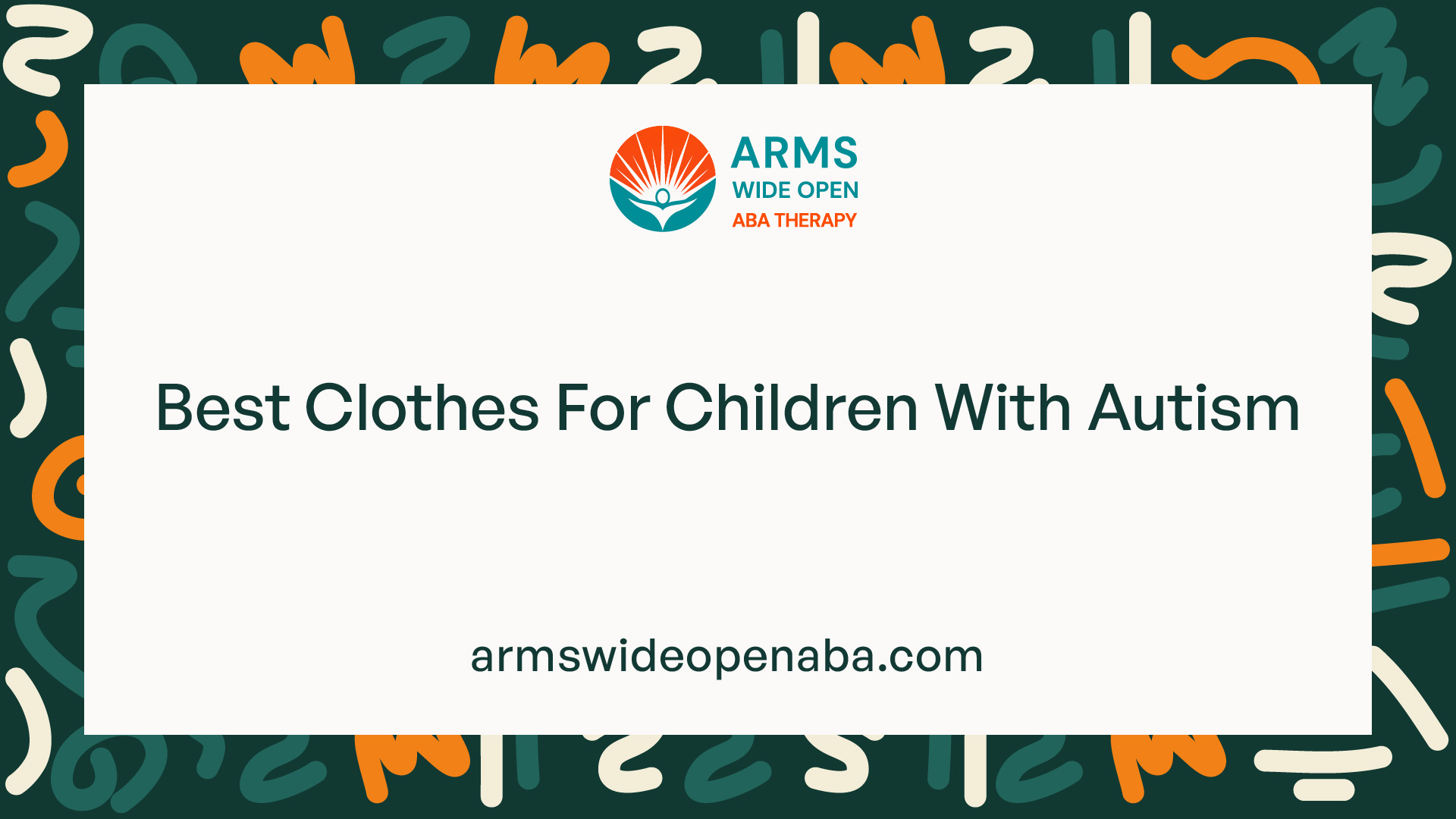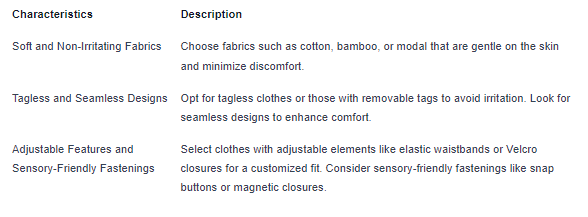Best Clothes For Children With Autism
Discover the best clothes for children with autism, designed for comfort and sensory needs. Find the perfect fit for your little one!

Understanding the Clothing Needs of Children with Autism
For children with autism, clothing choices can significantly impact their comfort and well-being. Understanding their unique sensory sensitivities and challenges is crucial in selecting the best clothes for them. Here, we will explore the sensory sensitivities and challenges experienced by children with autism and highlight the importance of comfortable and sensory-friendly clothing.

Sensory Sensitivities and Challenges
Children with autism often experience sensory sensitivities, which can make certain clothing textures, tags, seams, and fastenings extremely uncomfortable or even painful. They may have heightened sensitivity to touch, resulting in increased discomfort or irritation when wearing certain fabrics or dealing with specific clothing features. This sensitivity can make it challenging for them to tolerate typical clothing options and may lead to anxiety or meltdowns.
Sensory sensitivities can also extend to other aspects of clothing, such as temperature regulation. Some children with autism may struggle with temperature fluctuations, feeling either too hot or too cold. It's important to consider these factors when selecting clothes, ensuring they provide comfort and support throughout the day.
Importance of Comfortable and Sensory-Friendly Clothing
Comfortable and sensory-friendly clothing plays a vital role in promoting well-being and reducing sensory challenges for children with autism. By choosing the right clothes, parents and caregivers can create a sensory haven that supports the child's overall comfort and helps them navigate their daily activities more easily.
When it comes to fabric choices, opting for soft and non-irritating materials is essential. Fabrics like cotton, bamboo, and modal are often well-tolerated by children with autism due to their smooth texture and breathability. These fabrics minimize skin irritation and allow for better airflow, helping to regulate body temperature.
In addition to fabric, the design of clothing can significantly impact a child's comfort. Tagless and seamless designs are highly recommended, as they eliminate the potential discomfort caused by tags and irritating seams. Tags can be particularly bothersome for children with autism, leading to sensory overload and distraction. Seamless clothing ensures a smooth and uninterrupted sensory experience.
Furthermore, adjustable features and sensory-friendly fastenings are essential considerations. Clothing with adjustable waistbands, cuffs, and straps enables a customized fit that accommodates the child's sensory preferences and body shape. Sensory-friendly fastenings, such as Velcro closures or magnetic buttons, provide an alternative to traditional buttons or zippers, making dressing and undressing easier and more comfortable for children with autism.
By understanding the sensory sensitivities and challenges faced by children with autism and prioritizing comfortable, sensory-friendly clothing, parents and caregivers can create a supportive environment that enhances their child's well-being and promotes their independence.
Characteristics of the Best Clothes for Children with Autism
When it comes to choosing clothes for children with autism, certain characteristics can greatly enhance their comfort and sensory experience. Here are some key features to look for in the best clothes for children with autism:
Soft and Non-Irritating Fabrics
Children with autism often have heightened sensory sensitivities, making it essential to choose clothes made from soft and non-irritating fabrics. Fabrics like cotton, bamboo, and modal are gentle on the skin and can help minimize discomfort. Avoid fabrics with rough textures or excessive seams that may cause irritation or discomfort.
Tagless and Seamless Designs
Tags and seams can be a source of irritation for children with autism, causing discomfort and distraction. Opt for clothes with tagless designs or removable tags to avoid any potential discomfort. Additionally, seamless designs can contribute to a more comfortable sensory experience, reducing the chances of irritation or discomfort caused by seams rubbing against the skin.
Adjustable Features and Sensory-Friendly Fastenings
Children with autism may have specific sensory preferences when it comes to clothing fit and fastenings. Look for clothes with adjustable features such as elastic waistbands, drawstrings, or Velcro closures. These allow for a customized fit, accommodating individual preferences and ensuring optimal comfort. Sensory-friendly fastenings like snap buttons or magnetic closures can also be easier for children with autism to manage independently.
To summarize the characteristics of the best clothes for children with autism, refer to the table below:

By considering these characteristics when selecting clothes for children with autism, you can help create a sensory-friendly and comfortable environment that allows them to thrive.
Clothing Styles for Children with Autism
When it comes to choosing the best clothes for children with autism, certain styles and features can greatly enhance their comfort and sensory experience. Here are three clothing styles that are often recommended for children with autism:
Loose-Fitting and Breathable Clothing
Loose-fitting and breathable clothing is a popular choice for children with autism as it provides freedom of movement and minimizes sensory discomfort. These garments are typically made from soft and lightweight fabrics that allow for better airflow, preventing overheating and irritation.
Opting for clothing with a relaxed fit can also help reduce tactile sensitivity and provide a sense of ease. Loose-fitting pants, shirts, and dresses made from breathable materials like cotton or bamboo can be excellent choices for children with autism.
Compression Clothing
Compression clothing, such as compression shirts or leggings, can have a calming effect on children with autism. These garments provide gentle, consistent pressure to the body, which can help promote a sense of security and body awareness.
Compression clothing comes in various levels of compression, so it's important to choose the right amount of pressure based on individual preferences. It's recommended to consult with an occupational therapist or healthcare professional to determine the appropriate compression level for your child.
Adaptive Clothing and Sensory Tools
Adaptive clothing is designed specifically for individuals with sensory sensitivities and physical challenges. These garments feature innovative designs and functional elements that make dressing easier and more comfortable for children with autism.
Some common features of adaptive clothing include:
- Velcro or magnetic closures instead of traditional buttons or zippers, which can be challenging for children with fine motor difficulties.
- Tagless labels or tags placed on the outside of the garment to minimize tactile irritation.
- Seamless construction to prevent rubbing or chafing against the skin.
- Adjustable features, such as elastic waistbands or adjustable straps, to accommodate individual preferences and sensory needs.
In addition to adaptive clothing, sensory tools can also be incorporated into clothing to provide additional comfort and stimulation. These tools may include fidget bands, weighted pockets, or textured patches that can offer tactile input and promote self-regulation.
By considering these clothing styles and features, you can help create a sensory haven for children with autism, allowing them to navigate their daily activities with increased comfort and confidence. It's important to remember that every child is unique, so it may require some trial and error to find the clothing styles that work best for your child's specific sensory needs.
Tips for Choosing the Best Clothes for Children with Autism
When selecting clothes for children with autism, it is important to consider their individual sensory preferences and needs. Here are some helpful tips to guide you in choosing the best clothes for children with autism:
Consider Individual Sensory Preferences
Every child with autism has unique sensory sensitivities and preferences. Some may be sensitive to certain fabrics, textures, or clothing tags, while others may prefer specific types of clothing that provide sensory input. It is crucial to observe and understand your child's sensory needs when selecting clothes.
To accommodate different sensory preferences, opt for clothes made from soft and non-irritating fabrics, such as cotton or bamboo. These materials are gentle on the skin and less likely to cause discomfort or irritation. Additionally, consider tagless and seamless designs, as they minimize potential sensory triggers and provide a smoother sensory experience.
Involve the Child in the Decision-Making Process
Involving the child in the clothing selection process can empower them and enhance their sense of autonomy. Allow them to participate in choosing their own clothes, within appropriate boundaries. This involvement can help ensure that they feel comfortable and confident in their clothing choices.
Provide options that align with their sensory preferences, such as offering a selection of clothes with different fabric textures, colors, or patterns. Encourage their input and consider their choices while keeping practicality and appropriateness in mind.
Trial and Error: Finding What Works Best
Finding the best clothes for a child with autism often involves some trial and error. What works for one child may not work for another, so it is essential to be patient and open to experimentation. Start by introducing a few different clothing options and observe how your child responds to each one.
Pay attention to their nonverbal cues, such as facial expressions, body language, and behavior. If a particular clothing item seems to bother or distress them, take note and avoid similar features in future selections. On the other hand, if they show signs of comfort and ease, take note of those preferences and prioritize similar characteristics in future clothing choices.
Remember, finding the best clothes for children with autism is an ongoing process. As your child grows and develops, their sensory preferences may change. Stay attuned to their needs and adapt their clothing accordingly.
By considering individual sensory preferences, involving the child in decision-making, and being open to trial and error, you can help create a wardrobe that promotes comfort and sensory well-being for children with autism. Each child is unique, and with patience and understanding, you can find the best clothes that meet their specific needs.
Conclusion
Comfortable and sensory-friendly clothing can make a significant difference in the lives of children with autism. By understanding their unique sensory challenges and preferences, parents and caregivers can create a supportive environment that enhances their overall well-being.
Choosing clothes made from soft and non-irritating fabrics, tagless and seamless designs, and adjustable features can help reduce sensory triggers and promote comfort. Clothing styles such as loose-fitting and breathable garments, compression wear, adaptive clothing, and sensory tools can further enhance the child's sensory experience.
It is important to involve the child in the decision-making process to promote their autonomy while keeping practicality in mind. Finding the best clothes for children with autism may require some trial and error, but by staying attuned to their needs, parents and caregivers can create a wardrobe that promotes comfort and confidence.
Overall, prioritizing comfortable, sensory-friendly clothing is an excellent way to support children with autism in navigating their daily activities with greater ease. By promoting comfort and minimizing sensory challenges, parents and caregivers can help these children thrive.
Sources
https://www.crossrivertherapy.com/autism/best-clothes
https://www.abtaba.com/blog/clothes-for-children-autism
Similar articles
We’re here to help you

Our team is here to assist you in this process. Contact us for any assistance.
it’s easy to apply
We Accept Most Insurances
Our in-network insurance partnerships make ABA therapy more accessible to families throughout our service areas.







Our Insurance Process
We'll request your insurance details to help us verify your plan's coverage for ABA therapy. Once we've received this information, we'll walk you through your benefits, including copayments, deductibles and out-of-pocket maximums, so you know what to expect in advance.
Our team will then handle the preauthorization and all the necessary paperwork.
.svg)





















.jpeg)


































.jpeg)




.jpeg)







.jpeg)











.jpeg)
















